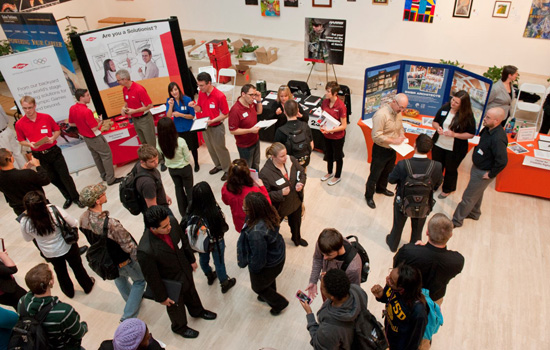NTID Job Fair connects students with employers
Hundreds of deaf and hard-of-hearing students meet prospective employers
Mark Benjamin, RIT/NTID
RIT/NTID students met with potential employers at the NTID Job Fair on Wednesday.
Representatives from more than 40 local, national and international companies met with hundreds of deaf and hard-of-hearing students Wednesday at the 14th annual Job Fair at Rochester Institute of Technology’s National Technical Institute for the Deaf.
Last year, 26 RIT/NTID students accepted 10-week co-ops or permanent jobs upon graduation as a result of the Job Fair.
Dressed in business attire and carrying résumés, the students had done their research, knowing what openings were available for each employer, whether the openings were co-ops or permanent jobs, and what majors were being sought.
An interpreter was available at each table. In many cases, the recruiter behind the table was an RIT/NTID alumnus, including Graham Forsey, a 2014 management information systems graduate of RIT/NTID who works as a business systems analyst for Whirlpool USA in Michigan.
“I talked with many students today, collected résumés and have 14 on my list for a second interview tomorrow,” Forsey said.
Other employers, some attending the fair for the first time, liked the variety of talent the students brought, including skills in business, finance, cinematography, engineering and computing.
“RIT/NTID students make very nice fits for us,” said Leslie Crawford, deputy director of the Office of Minority and Women Inclusion for the Federal Deposit Insurance Corporation (FDIC). “I’m impressed. I would like to come back next year.”
Prior to the fair, prospective employers attended a luncheon and learned about working with deaf and hard-of-hearing students from representatives of companies that have worked well with RIT/NTID students.
John Macko, director of NTID’s Center on Employment, said the top three questions prospective employers have about hiring deaf and hard-of-hearing workers are how will communication work, how safe are deaf employees working with machines or chemicals and what is the cost of accommodations.
“Actually, it was easier than we thought it would be,” said Stacy Halliday, a representative of Air Products. “We told our deaf employee about our regular safety practices and things we should and shouldn’t do. We didn’t need to have any extra safety training.”
“A lot of the interpreting and accommodation was cheaper than we thought it would be,” said Ashley Stark, who was representing Bank of NY-Mellon. “We use a lot of email and instant messaging with managers.”
Halliday said managers evaluated their experience after the student’s co-op had ended and said having a deaf team member helped them work better, especially in group discussions. “They said it taught them how to listen and interact with each other, listen to each other better in meetings. They didn’t realize how much they were talking over each other.”
Two employers were honored for hiring a number of RIT/NTID students for co-ops or permanent jobs in recent years. The FDIC and the Aspen (Colorado) Camp of the Deaf and Hard of Hearing received Outstanding Employer Award for hiring 11 and 14 RIT/NTID students respectively in the past five years.
Also at the luncheon, NTID President Gerry Buckley said the college’s relationship with employers remains very important. “Thanks to companies like yours, we are making positive improvements in career options for deaf and hard-of-hearing students,” he said. Historically, more than 90 percent of RIT/NTID graduates seeking employment find a job within a year of graduation.
One of nine colleges of RIT, NTID was established by Congress in 1965 to provide college opportunities for deaf and hard-of-hearing individuals who were underemployed in technical fields. Today, 1,387 students attend NTID; more than 1,200 are deaf or hard of hearing. Others are hearing students enrolled in interpreting or deaf education programs. RIT is the most accessible campus for deaf students, providing unparalleled support services with more than 150 interpreters, tutors and notetakers who support students in and out of the classroom.



